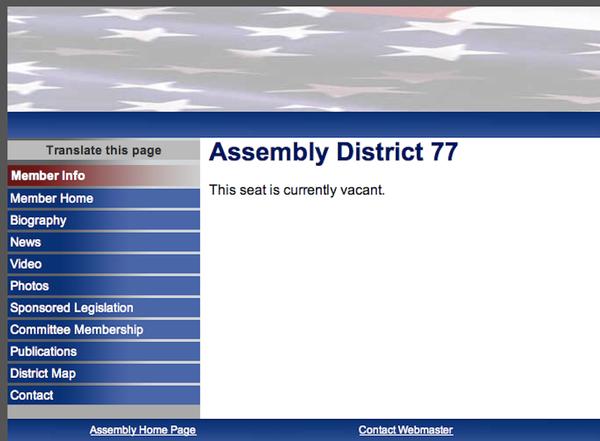
Photo by: NYS assembly
The webpage for former Assemblywoman Vanessa Gibson’s seat, now vacant because she was elected to the New York City Council, makes clear what is a fact for its residents and those of one other Bronx district and nine more throughout the state: They have no representation in the lower house of the state legislature.
There’s a good chance that 250,000 Bronx residents will have no representation in the state Assembly during the nine months between now and Nov. 5. That’s because two seats — out of 11 statewide Assembly and Senate seats — are vacant and Governor Andrew Cuomo has yet to decide whether to fill them before the general election.
On Jan. 17, Cuomo was asked by Susan Arbetter on WCNY’s Capital Press Room show if he is “going to call special elections for the 11 open seats.”
He’s struggling with the decision.
“We are looking at that now; you know, it seems like every week there is another open seat, given the travails of our friends in the legislature,” Cuomo responded, chuckling. “And if you have to do special elections, they are very expensive to do because you basically have to run a separate election, obviously. So it’s not something you want to do lightly. I would like to know what the legal effects are and I would like to know on a practical level how many more shoes are going to drop here and how many people are going to be leaving office.”
Rather than wait until Jan. 1, 2015, to be sworn in with other newly elected state legislators, a candidate for an empty seat would take office as soon as he or she wins: either after the general election in November, or a special one called earlier.
In the Bronx, former Assemblywoman Vanessa Gibson left her District 77 seat open when she won the election to replace City Councilwoman Helen Foster who, due to term limits, couldn’t run again. (Foster was appointed commissioner of the State Division of Human Rights.)
District residents can’t even learn about the district itself on the former state legislator’s website because its text has been completely removed .
Almost the same is true of District 79, where addresses and phone numbers are listed for the Bronx and Albany offices but there is no reference to the district or anyone’s name.
Last month, the assemblyman for that district, Eric Stevenson, was found guilty of taking $22,000 in bribery to help senior center developers. He was removed from office immediately.
Imperfect choices
If Cuomo moves ahead with an election prior to the existing September primary that exists for all districts, candidates would have just 70 days after the governor announces his decision to gather signatures, raise money and run for office.
Most Bronx elected officials think a non-primary election should happen as soon as possible.
“It’s outrageous,” Assemblyman Jeffrey Dinowitz says. “We have two empty Assembly seats. Those communities don’t have a state assemblyman. It’s one less source of help and one less voice to fight for a community.”
Dinowitz understands the other side of his argument: that special elections almost always elevate candidates backed by the county Democratic machine. “Those who would oppose this would argue that they are handpicked by political leadership because there is no primary process,” he says. “Personally, I just think that though there’s a downside, every community deserves representation. No taxation without representation.”
Districts 77 and 79 border each other in the southwest Bronx. Gibson, who would like to have her former seat filled as soon as possible, says this creates even a greater political crisis.
“It would be a great disservice if Cuomo did not call an election as soon as possible,” she says, adding, “The two Assembly districts make up a majority of my Council district, [constituents] who have no representation in the Assembly. … There are critical decisions that need to be made this year that are related to the budget, education, higher education, housing, healthcare.”
Assemblyman Carl Heastie, the borough’s Democratic Party chair, agrees. “We’re always behind the eight-ball,” he says. “So having two less people in Albany fighting for the Bronx is a problem.”
The wild card: A June primary?
What all Bronx elected officials seem to share is deep uncertainty for what’s to follow.
“We’ve heard speculation that there might be a special election called,” Gibson says. “It might be an effort to have a primary in June, but that has to go through the legislative process in both houses. Right now, everyone is in limbo waiting for an announcement.”
Gibson is referring to the possibility that the primary for all state offices will move from September back to June, when federal primaries—for House and Senate seats—occur. The Assembly last month passed a bill calling for a state primary in June. The Senate is considering a rival proposal for an August primary. Even if the state primary doesn’t move to June, Cuomo could schedule a special election for the empty legislative seats for that month.
South Bronx activist Mychal Johnson sees that as the best option.
“I would think they should push it up until June rather than September,” he says. “But to have one special election right now, a lot of taxpayer money will be used for that. As bad as I feel as people not being represented by an Assembly member, it might not be cost effective to do that right now.”
Johnson adds: “If you’re not already part of the established Democratic machine in our borough it would be hard for you to run if you wanted to. You’d have to be very established. Six weeks is not enough to establish a good ground game.”








